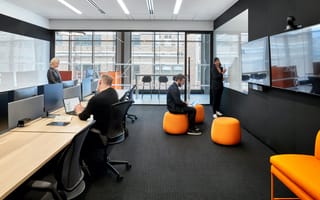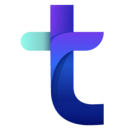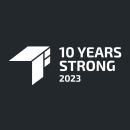The goal of all innovation is relevant improvement, whether that involves iterating a former process or introducing entirely new initiatives. Regardless of the method, the ultimate objective is to alter an industry’s landscape for the better.
Within the mental healthcare space, Click Therapeutics is working to expand access to treatment and resources by launching a new form of therapy. In any given year, major depressive disorder affects 7.1 percent of the U.S. population age 18 and older — approximately 17.3 million adults. However, both access to resources and the treatment methods themselves are not broad enough to meet patients’ needs.
According to Heather Morris, senior engineering manager, many of those who do reach treatment don’t respond to the current methods available. Click’s solution: a treatment modality that can be delivered through an app allowing for broader access to care. The most innovative part? It is only made possible through software.
The use cases, modeling methods and infrastructure tinkering doesn’t stop there. And neither does the impact. To learn more about the latest exciting projects and the innovations in transportation, digital media and beyond, we met with five tech leaders that are paving paths in their industries.
What’s the coolest project you’ve worked on recently? What made it so innovative or exciting?
The coolest recent project was the introduction of GIFs as a new content type for our software development toolkit (SDK).
The addition of GIFs expanded the Holler content offering, giving our guests more choices to enhance their conversations. For this project, the requirement included delivery of GIF recommendations using a cloud-based connection and represented our first connected delivery to a mobile device. Since we are integrated into messaging, we needed to be able to deliver sub-second response times to millions of users. Who wants to wait even one second for cool content while typing a text message?
To achieve our goals, we defined a new extensible architecture, both infrastructure and application, to enable the delivery of Holler and third-party content at scale via API. The architecture is crafted to support the migration of our legacy systems. We implemented a K8 based microservice architecture, incorporating both RESTful- and gRPC- (http2) based services.
We successfully delivered the infrastructure and the GIF content in six months, and have set the direction for Holler to deliver cloud-based content to anyone.
What do you envision for the future of your industry? And how is your work helping to shape that future and bring it to life?
I envision an explosion of conversational media within our industry, and Holler has an opportunity to be a leader in this space. Messaging is the most popular form of communication today, and Holler provides the content people look for to enhance those digital conversations. I am confident that the appetite for messaging content will only increase, which is why we’re building the technology and the content library necessary to provide that to the end user.
The engineering team and the work we completed to deliver cloud-based content (the architecture described above) is a cornerstone to our success. Content delivered through a service, for millions of people at sub-second response time, enables Holler to envision and then deliver different forms of content across different platforms to all types of people.
What’s the coolest project you’re working on at the moment? What makes it so innovative or exciting?
Truveris is scaling quickly. For our engineers, this means processing larger datasets more frequently. And as any engineer knows, a proven business model means existing code. An architecture created for historical demands is not going to be aligned with the future.
Picking up a copy of “Data Pipelines for Dummies” at the local bookstore is not a viable solution for our scaling needs, and a full rewrite is rarely successful or timely. How do you take a system that is approaching its limits, replace it with a modern stack, all the while keeping the people who use it happy?
This challenge is what I find interesting and exciting about working at Truveris. Push-button cloud has made yesterday’s challenge a commodity. Replacing an engine while racing is the definition of exciting.
What do you envision for the future of your industry? And how is your work helping to shape that future and bring it to life?
Twenty years ago it was software that ate the world. Today it is data.
However, data is useless if there is no means to extract actionable information. That is the direction that we are taking. More valuable insights from data that will help our clients make better decisions. New processing capabilities will provide more ways to slice data and better answer the question of, “Where is my money going?” After all, who doesn’t want a clearer answer to that?
What’s the coolest project you’ve worked on recently? What made it so innovative or exciting?
We recently tackled a really interesting problem relating to how one defines and quantifies the similarity between any two lanes, where a lane consists of a pickup zip code and a delivery zip code. We have high levels of temporal and geographic sparsity across our internal data and our third party data. We have developed a robust similarity metric and associated algorithms for any pair of lanes, which has opened up new analytic and modeling capabilities, allowing our existing data sets to cover more use cases. What I find most rewarding about this project is that we were able to take a very technical idea and construct something that can be integrated throughout our organization. It’s exciting to know that my day-to-day work has a direct impact on the organization, my colleagues and our success as a company.
What do you envision for the future of your industry? And how is your work helping to shape that future and bring it to life?
From its inception, Transfix has been applying technology to transportation logistics to eliminate the waste, inefficiency and friction that has long been part of the process of booking and moving freight. To that end, my role as a data scientist at Transfix is to understand each touch point in the shipment lifecycle, then find ways to apply data and machine learning to remove friction, add intelligence and improve capabilities.
During my tenure, we’ve built foundational technologies to price and bid for freight in both the spot and contract markets. We’ve also built a stable of predictive models to help teams across the organization get out in front of common operational challenges faced by freight brokers and 3PLs. Finally, we have up leveled the company’s ability to forecast internal KPIs, allowing for better monitoring and planning of our operations. Looking ahead, we continue to develop solutions designed to recommend loads to carriers that minimize empty truck miles, provide consistent cost to our customers, and facilitate the movement of freight through supply chains.
What’s the coolest project you’re working on at the moment? What makes it so innovative or exciting?
My most exciting project goes by the code name CT-152. It’s an investigational treatment for Major Depressive Disorder that is delivered in the form of a phone app. CT-152 is not the first app to attempt to provide mental health treatment via an app, but it’s the first to be developed as a new type of therapy that goes through clinical trials, FDA review and can be prescribed.
The innovative thing about CT-152 is that it’s not just translating a traditional treatment modality into app form, but rather delivering a novel treatment that is only made possible through software. The CT-152 application is currently in clinical trials as an adjunct to treatment with depression medication.
We are not working on the next drug, or the latest trend in mindfulness or meditation, but a totally new kind of treatment that has only ever been tried in a research setting. We are really pushing the bounds of mental health treatment.
What do you envision for the future of your industry? And how is your work helping to shape that future and bring it to life?
The future of the industry is a place where mental health treatment is easily and affordably accessible to the people who need it. The barrier to seeking treatment is incredibly high, not just financially — many mental health ailments make just the thought of seeking treatment seem too hard to even attempt. Of those who do get treatment, many are non-responders to the current methods available. Our work is bringing a new treatment path to life. It is also delivered in an at-home and self-directed way, which will enable individuals to access treatment when they might not have been able to otherwise.
What’s the coolest project you’ve worked on recently? What made it so innovative or exciting?
I’d say one of my most impactful projects was taking our model development time from a few days down to a few hours. One of the pain points of our original infrastructure was the way we were moving data through a heavily manual process. To eliminate that major bottleneck, I wrote an API wrapper around a web interface so we could automate the entire process of manual data file uploads and downloads. By refactoring and chaining together Python scripts, we could run the entire process automatically overnight and have a new updated model in the morning.
What do you envision for the future of your industry? And how is your work helping to shape that future and bring it to life?
The future of the AI search industry involves automatic model evaluations, industry- and client-specific models, robust search quality metrics and more! Our work in creating search quality metrics is already realizing that future. Natural language processing plays a huge role in search (because search engines need to actually understand what a person is asking for to deliver an answer), and it’s notoriously complex. Traditionally, model evaluations have been done manually — with people judging if results are good or not — but this isn’t a sustainable approach, especially if 20 models need to be updated and deployed in different languages every night.
Today, we can automatically determine if a model is creating better search results and deploy new models every day. It’s a key component of scalability, and more importantly, giving people the confidence that the models powering their search experiences are performing well. As we improve our labeling and training infrastructure, our data flywheel will also enable us to spin up those models for even better performance.














